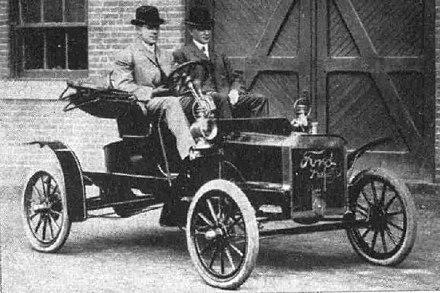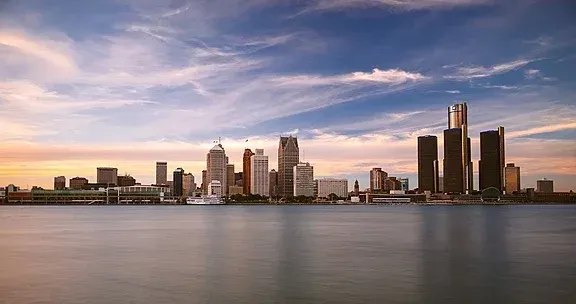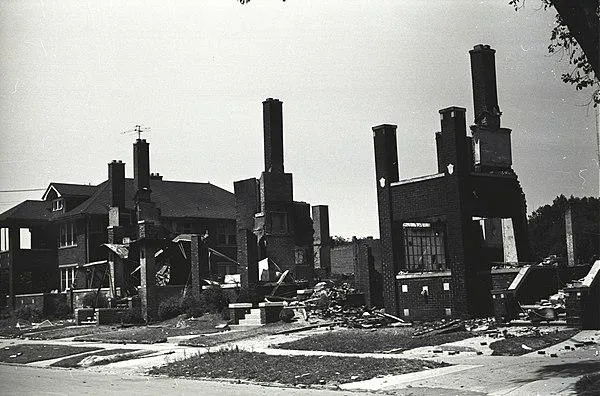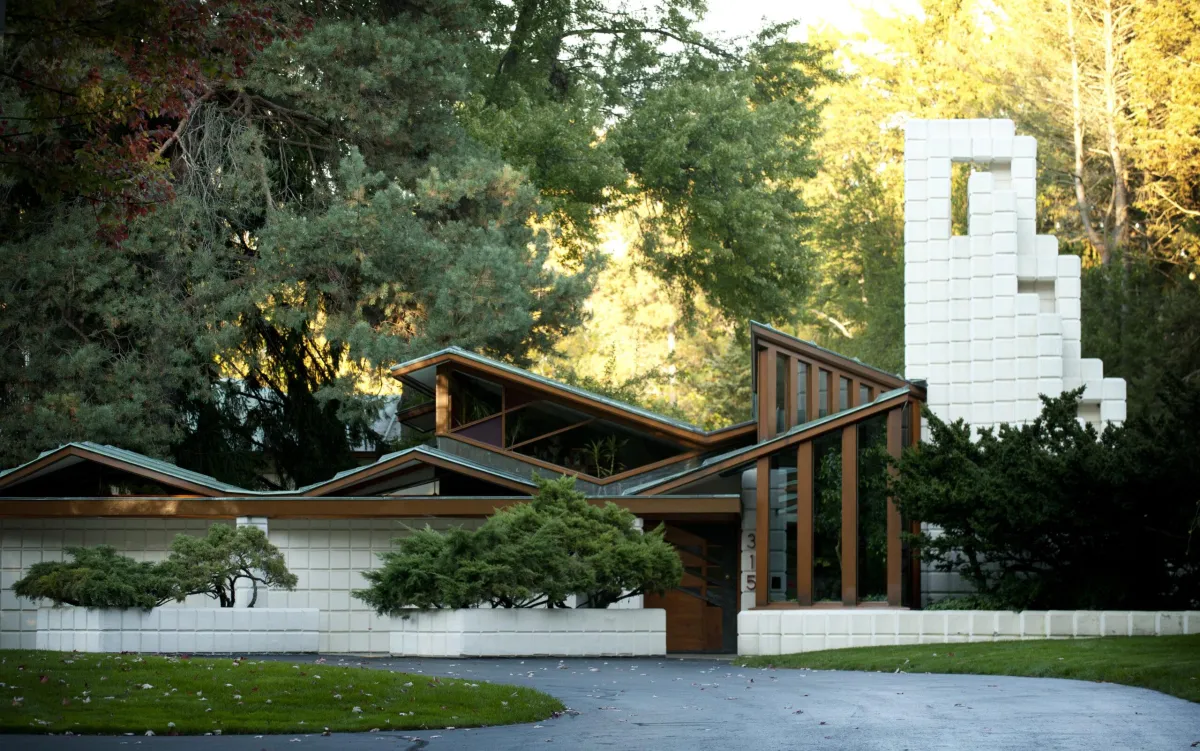
The History of Detroit, Michigan
Introduction: The Rich History of Detroit, Michigan
Detroit, Michigan, is a city with a vibrant and complex history. From its beginnings as a French trading post in the early 18th century to becoming the epicenter of the global automotive industry in the 20th century, Detroit has experienced periods of immense growth, cultural innovation, and significant challenges. Its story reflects the evolution of the United States as a whole, with major economic, social, and industrial transformations that continue to shape the city today.
The Founding of Detroit: A Strategic Outpost (1701)

What To Do If Your Vehicle Has Hail Damage
Detroit was founded in 1701 by the French explorer Antoine de la Mothe Cadillac, who established it as Fort Pontchartrain du Détroit. The location was chosen for its strategic significance along the Detroit River, allowing the French to control fur trade routes and defend against British advances. The city’s name, "Detroit," comes from the French word for "strait," referring to the river between Lake Erie and Lake St. Clair. Early settlers included French fur traders, soldiers, and missionaries who laid the foundation for the city’s future growth.
As a French fort, Detroit played a key role in North American trade. It became a bustling trading post, where Native Americans, French settlers, and European traders exchanged furs, goods, and information. Following British control after the French and Indian War, Detroit continued to thrive as a hub of commerce. The city’s location on the Great Lakes waterway cemented its importance for transporting goods, giving it a central role in the early economy of the Midwest.
Detroit’s Growth as a Manufacturing Powerhouse in the 19th Century

What To Do If Your Vehicle Has Hail Damage
By the mid-19th century, Detroit was becoming a prominent industrial center. Factories sprang up along the river, and the city's population boomed as workers arrived to take advantage of the growing job opportunities. The construction of the Erie Canal in the 1820s, connecting the Great Lakes to the Atlantic Ocean, further enhanced Detroit’s ability to grow as an industrial powerhouse. The arrival of railroads in the 1850s linked Detroit with other major cities, strengthening its position as a key transportation hub.
Detroit's economic transformation took off as factories began producing stoves, ships, and other manufactured goods. By the late 19th century, industries like shipbuilding and manufacturing were helping Detroit become a booming industrial metropolis. This era laid the groundwork for the city’s automotive revolution in the early 20th century. As factories expanded, so did the city’s need for labor, contributing to Detroit’s rapid growth.
The Motor City: How the Auto Industry Defined Detroit

The rise of Detroit as "The Motor City" is tied directly to the automotive industry, which transformed the city into an industrial powerhouse. In 1903, Henry Ford founded the Ford Motor Company, and in 1913, he introduced the moving assembly line, revolutionizing manufacturing worldwide. This innovation allowed Ford to produce affordable cars like the Model T in record time. Ford’s higher wages, known as the "Five-Dollar Day," attracted thousands of workers to Detroit, fueling the city’s growth.
Detroit became synonymous with the American auto industry, home to the "Big Three" automakers: Ford, General Motors, and Chrysler. The city’s economy soared as the demand for cars increased, making Detroit a global leader in manufacturing. By the mid-20th century, nearly 70% of all American cars were produced in the city. Detroit’s rise as the Motor City played a key role in establishing the middle class, offering good wages and stable jobs to thousands of Americans.
The Great Migration and Cultural Transformation in Detroit

During the early 20th century, Detroit saw a large influx of African Americans moving from the rural South to the industrial North, a movement known as the Great Migration. These new residents sought better job opportunities in the city’s booming factories. African Americans became a vital part of Detroit’s workforce, contributing to the city’s growth and reshaping its social and cultural landscape.
The cultural impact of the African American community in Detroit was profound. The city became a center for jazz, blues, and, later, the Motown sound. In 1959, Berry Gordy Jr. founded Motown Records, and Detroit became the birthplace of iconic music acts such as The Supremes, Marvin Gaye, and Stevie Wonder. Motown Records not only changed the music industry but also became a symbol of African American entrepreneurial success.
Motown’s influence extended beyond music. It played a crucial role in the Civil Rights Movement, bridging racial divides through its universal appeal. Detroit’s status as a cultural hub was cemented through Motown, earning it a lasting legacy in American music history.
The Challenges of the Post-War Era and the 1967 Detroit Rebellion
Following World War II, Detroit experienced a shift as suburbanization, deindustrialization, and racial tensions began to impact the city. As factories began to close or move to suburban areas, many middle-class residents left Detroit, leading to economic decline and depopulation in the city center. This resulted in increased unemployment and poverty, which disproportionately affected the African American community.
These tensions culminated in the Detroit Rebellion of 1967, one of the largest urban uprisings in U.S. history. Sparked by longstanding racial inequities and police brutality, the rebellion lasted five days, resulting in significant damage to the city and the loss of lives. This event highlighted the racial and economic challenges Detroit faced and marked a turning point in the city’s modern history.
Detroit’s Modern Revitalization and Architectural Preservation
Despite its challenges, Detroit has made significant strides toward revitalization in recent years. Efforts to preserve its architectural heritage are evident in the restoration of iconic buildings such as the Guardian Building and the Fisher Building. These landmarks reflect Detroit’s vibrant past and are now symbols of its ongoing recovery.
Detroit’s comeback story is marked by new developments in industries like technology and real estate, as well as cultural renewal. The city’s downtown area has seen significant investment, with new businesses and creative ventures springing up. Though the city still faces challenges, Detroit remains a testament to resilience, and its history serves as a foundation for its promising future.
Conclusion
Detroit, Michigan, is a city with a rich and dynamic history, founded in 1701 as a French fur trading post. Over the centuries, it transformed into a major industrial hub, thanks largely to the rise of the automobile industry. Henry Ford’s introduction of the assembly line in the early 20th century earned Detroit its nickname “The Motor City.” The city also became a cultural hotspot, especially during the Great Migration, which saw African-Americans moving to Detroit for work opportunities, contributing to the rise of Motown music. However, Detroit faced challenges in the latter part of the 20th century, including economic decline, population loss, and the 2013 bankruptcy. Today, the city is experiencing a resurgence, with revitalization efforts aimed at restoring its economic and cultural vibrancy. From its industrial roots to its role in music and culture, Detroit’s history is one of resilience and reinvention.
Question and Answers about Detroit, Michigan
Q. What is the history of Detroit, Michigan?
A. Detroit was founded in 1701 as a French trading post by Antoine de la Mothe Cadillac. It became an industrial powerhouse in the 19th century and earned the nickname "The Motor City" after the rise of the automotive industry, led by Henry Ford’s assembly line. Despite facing economic challenges, including a bankruptcy in 2013, Detroit is currently undergoing a revitalization, attracting new businesses and industries.
Q. Why is Detroit called The Motor City?
A. Detroit earned its nickname “The Motor City” because of its pivotal role in the automotive industry. In the early 20th century, companies like Ford, General Motors, and Chrysler were based in the city and revolutionized car manufacturing through mass production techniques, especially the assembly line.
Q. What role did Motown music play in Detroit’s history?
A. Motown Records, founded by Berry Gordy in 1959 in Detroit, became a cultural phenomenon that produced some of the most famous musical acts in history, including Stevie Wonder, The Supremes, and Marvin Gaye. Motown helped bridge racial divides and shaped the sound of American music, making Detroit a musical landmark.
Q. How has Detroit's economy evolved over time?
A. Detroit’s economy was historically centered around the auto industry, but after the decline in manufacturing during the 20th century, the city faced significant economic struggles. However, in recent years, Detroit has diversified its economy, focusing on technology, real estate development, and small businesses, which have contributed to its recovery.
Q. What is the significance of Detroit's revitalization efforts?
A. Detroit’s revitalization is an ongoing effort to restore the city’s economy, infrastructure, anCoded cultural institutions after years of decline. New investments in downtown areas, historical preservation, and the attraction of new industries are central to these efforts, helping bring back jobs, businesses, and residents to the city.
Monday - Friday: 10:00 AM - 7:00 PM
Saturday: 11:00 AM - 5:00 PM
Sunday: Closed

The History of Detroit, Michigan
Introduction: The Rich History of Detroit, Michigan
Detroit, Michigan, is a city with a vibrant and complex history. From its beginnings as a French trading post in the early 18th century to becoming the epicenter of the global automotive industry in the 20th century, Detroit has experienced periods of immense growth, cultural innovation, and significant challenges. Its story reflects the evolution of the United States as a whole, with major economic, social, and industrial transformations that continue to shape the city today.
The Founding of Detroit: A Strategic Outpost (1701)

Detroit was founded in 1701 by the French explorer Antoine de la Mothe Cadillac, who established it as
Fort Pontchartrain du Détroit. The location was chosen for its strategic significance along the Detroit River, allowing the French to control fur trade routes and defend against British advances. The city’s name, "Detroit," comes from the French word for "strait," referring to the river between Lake Erie and Lake St. Clair. Early settlers included French fur traders, soldiers, and missionaries who laid the foundation for the city’s future growth.
As a French fort, Detroit played a key role in North American trade. It became a bustling trading post, where Native Americans, French settlers, and European traders exchanged furs, goods, and information. Following British control after the French and Indian War, Detroit continued to thrive as a hub of commerce. The city’s location on the Great Lakes waterway cemented its importance for transporting goods, giving it a central role in the early economy of the Midwest.
Detroit’s Growth as a Manufacturing Powerhouse in the 19th Century
By the mid-19th century, Detroit was becoming a prominent industrial center. Factories sprang up along the river, and the city's population boomed as workers arrived to take advantage of the growing job opportunities. The construction of the Erie Canal in the 1820s, connecting the Great Lakes to the Atlantic Ocean, further enhanced Detroit’s ability to grow as an industrial powerhouse. The arrival of railroads in the 1850s linked Detroit with other major cities, strengthening its position as a key transportation hub.
Detroit's economic transformation took off as factories began producing stoves, ships, and other manufactured goods. By the late 19th century, industries like shipbuilding and manufacturing were helping Detroit become a booming industrial metropolis. This era laid the groundwork for the city’s automotive revolution in the early 20th century. As factories expanded, so did the city’s need for labor, contributing to Detroit’s rapid growth.
The Motor City: How the Auto Industry Defined Detroit

The rise of Detroit as "The Motor City" is tied directly to the automotive industry, which transformed the city into an industrial powerhouse. In 1903, Henry Ford founded the Ford Motor Company, and in 1913, he introduced the moving assembly line, revolutionizing manufacturing worldwide. This innovation allowed Ford to produce affordable cars like the Model T in record time. Ford’s higher wages, known as the "Five-Dollar Day," attracted thousands of workers to Detroit, fueling the city’s growth.
Detroit became synonymous with the American auto industry, home to the "Big Three" automakers: Ford, General Motors, and Chrysler. The city’s economy soared as the demand for cars increased, making Detroit a global leader in manufacturing. By the mid-20th century, nearly 70% of all American cars were produced in the city. Detroit’s rise as the Motor City played a key role in establishing the middle class, offering good wages and stable jobs to thousands of Americans.
The Great Migration and Cultural Transformation in Detroit

During the early 20th century, Detroit saw a large influx of African Americans moving from the rural South to the industrial North, a movement known as the Great Migration. These new residents sought better job opportunities in the city’s booming factories. African Americans became a vital part of Detroit’s workforce, contributing to the city’s growth and reshaping its social and cultural landscape.
The cultural impact of the African American community in Detroit was profound. The city became a center for jazz, blues, and, later, the Motown sound. In 1959, Berry Gordy Jr. founded Motown Records, and Detroit became the birthplace of iconic music acts such as The Supremes, Marvin Gaye, and Stevie Wonder. Motown Records not only changed the music industry but also became a symbol of African American entrepreneurial success.
Motown’s influence extended beyond music. It played a crucial role in the Civil Rights Movement, bridging racial divides through its universal appeal. Detroit’s status as a cultural hub was cemented through Motown, earning it a lasting legacy in American music history.
The Challenges of the Post-War Era and the 1967 Detroit Rebellion
Following World War II, Detroit experienced a shift as suburbanization, deindustrialization, and racial tensions began to impact the city. As factories began to close or move to suburban areas, many middle-class residents left Detroit, leading to economic decline and depopulation in the city center. This resulted in increased unemployment and poverty, which disproportionately affected the African American community.
These tensions culminated in the Detroit Rebellion of 1967, one of the largest urban uprisings in U.S. history. Sparked by longstanding racial inequities and police brutality, the rebellion lasted five days, resulting in significant damage to the city and the loss of lives. This event highlighted the racial and economic challenges Detroit faced and marked a turning point in the city’s modern history.
Detroit’s Modern Revitalization and Architectural Preservation
Despite its challenges, Detroit has made significant strides toward revitalization in recent years. Efforts to preserve its architectural heritage are evident in the restoration of iconic buildings such as the Guardian Building and the Fisher Building. These landmarks reflect Detroit’s vibrant past and are now symbols of its ongoing recovery.
Detroit’s comeback story is marked by new developments in industries like technology and real estate, as well as cultural renewal. The city’s downtown area has seen significant investment, with new businesses and creative ventures springing up. Though the city still faces challenges, Detroit remains a testament to resilience, and its history serves as a foundation for its promising future.
Conclusion
Detroit, Michigan, is a city with a rich and dynamic history, founded in 1701 as a French fur trading post. Over the centuries, it transformed into a major industrial hub, thanks largely to the rise of the automobile industry. Henry Ford’s introduction of the assembly line in the early 20th century earned Detroit its nickname “The Motor City.” The city also became a cultural hotspot, especially during the Great Migration, which saw African-Americans moving to Detroit for work opportunities, contributing to the rise of Motown music. However, Detroit faced challenges in the latter part of the 20th century, including economic decline, population loss, and the 2013 bankruptcy. Today, the city is experiencing a resurgence, with revitalization efforts aimed at restoring its economic and cultural vibrancy. From its industrial roots to its role in music and culture, Detroit’s history is one of resilience and reinvention.
Question and Answers about Detroit, Michigan
Q. What is the history of Detroit, Michigan?
A. Detroit was founded in 1701 as a French trading post by Antoine de la Mothe Cadillac. It became an industrial powerhouse in the 19th century and earned the nickname "The Motor City" after the rise of the automotive industry, led by Henry Ford’s assembly line. Despite facing economic challenges, including a bankruptcy in 2013, Detroit is currently undergoing a revitalization, attracting new businesses and industries.
Q. Why is Detroit called "The Motor City"?
A. Detroit earned its nickname “The Motor City” because of its pivotal role in the automotive industry. In the early 20th century, companies like Ford, General Motors, and Chrysler were based in the city and revolutionized car manufacturing through mass production techniques, especially the assembly line.
Q. What role did Motown music play in Detroit’s history?
A. Motown Records, founded by Berry Gordy in 1959 in Detroit, became a cultural phenomenon that produced some of the most famous musical acts in history, including Stevie Wonder, The Supremes, and Marvin Gaye. Motown helped bridge racial divides and shaped the sound of American music, making Detroit a musical landmark.
Q. How has Detroit's economy evolved over time?
A. Detroit’s economy was historically centered around the auto industry, but after the decline in manufacturing during the 20th century, the city faced significant economic struggles. However, in recent years, Detroit has diversified its economy, focusing on technology, real estate development, and small businesses, which have contributed to its recovery.
Q. What is the significance of Detroit's revitalization efforts?
A. Detroit’s revitalization is an ongoing effort to restore the city’s economy, infrastructure, anCoded cultural institutions after years of decline. New investments in downtown areas, historical preservation, and the attraction of new industries are central to these efforts, helping bring back jobs, businesses, and residents to the city. similique quisquam et deserunt, recusandae. here

Written By: E. Bel.
Tax professional and manager with 12+ years experience in the tax industry
(313) 367- 0365
Service Hours
Monday - Friday: 10:00 AM - 7:00 PM
Saturday: 11:00 AM - 5:00 PM
Sunday: Closed
Social Media
















